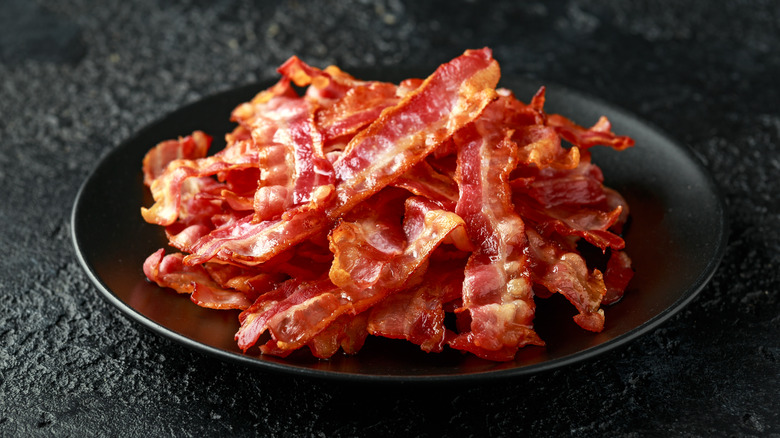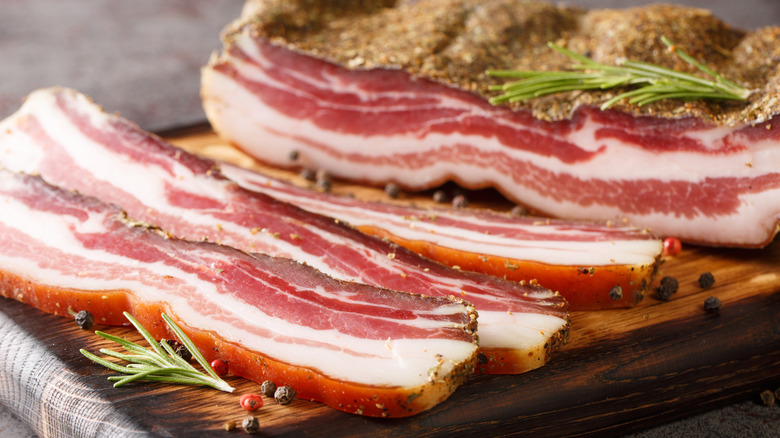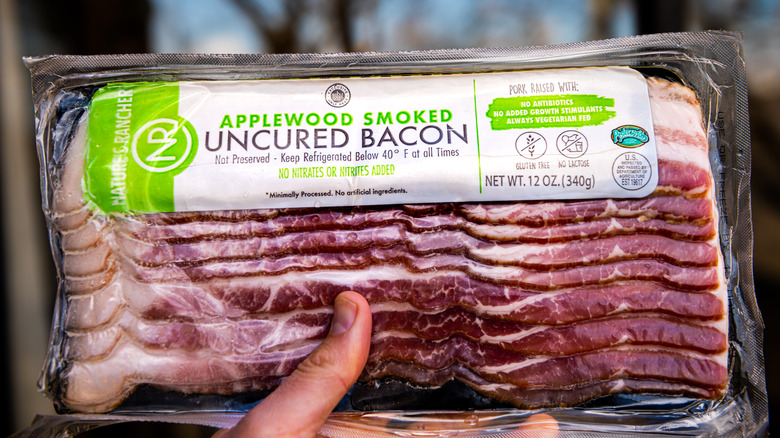Is There A Difference Between Cured And Uncured Bacon?
We enjoy pork in many forms, but bacon always seems to hover at the top of that list. If not most people's favorite preparation of the pig, it's safe to claim it as a breakfast staple, especially when it's at its crispiest. Maybe Linda Papadopoulos, sensory and consumer researcher at Oscar Mayer, summed it up well, saying it's "that perfect combo of the sweet, the salty, the smoky and the savory character" (via CNN).
There has never been a bologna or ham menu movement — but perhaps there should be. And with popular foods tend to come more labels and possibly more confusion — bacon has not escaped this parallel. From the cut to the smoking to the curing, it's easy to get lost amongst the rashers.
Bacon is primarily cut from the belly or back of the pig, and depending on what country you are in, it can also come from the loin, jowls, or sides of the animal. What makes bacon, bacon, and not just a cut from the pork belly or loin, is what happens to the meat after butchering. Bacon becomes bacon once it undergoes curing (via Barbecue FAQ).
What exactly is curing, and what's the difference between cured and uncured bacon? Should you opt for one label over the other?
Curing meat makes it last longer
Curing any type of meat is simply a means of preserving it. And there are two methods of curing pork meat to make bacon: dry curing and wet curing. Dry curing is the more traditional method that involves rubbing generous amounts of salt, seasonings, and sometimes sugar onto the meat and allowing it to sit for one to two weeks (via The Washington Post). The bacon is then rinsed and usually smoked before it ends up on your plate.
While dry curing lends a more complex flavor and process, wet curing is the industrial procedure and most likely the method used to cure the bacon you see on shelves. The sugar, salt, seasonings, plus chemicals are made into brine and injected into the bacon. A less-common method of curing is submerging the meat in the brine liquid and allowing it to soak, also termed immersion curing (via S. Clyde Weaver).
Bacon is cured naturally or synthetically
When it comes to uncured bacon, well, there is no such thing — all bacon fit for consumption is cured by nitrites. Nitrites are what are responsible for bacon's color and unique flavor. They act as a preservative in the meat and give it a longer shelf-life (via The Meat We Eat).
Whether those nitrites occur naturally or are synthetic is where the labeling nuances come into play. The USDA only requires that synthetic nitrites, like sodium nitrite, carry the cured label. Any bacon cured naturally by the nitrates present in vegetables and fruit or sea salt can don the "uncured" label. Naturally occurring nitrates are converted into nitrites by bacteria that, in turn, cure the meat. Per the USDA, any product labeled "uncured" that contains natural nitrates must add, "no nitrates or nitrites added except for those naturally occurring in ingredients such as celery juice powder, parsley, cherry powder, beet powder, spinach, sea salt etc."
Before buying nitrate-free bacon, you should know that the amount of these sorts of compounds legally allowed in food products is limited due to potential adverse health effects. Manufacturers' products are strictly monitored, per Healthline – but if you prefer to limit your exposure, it's best to check the labels for additives.


